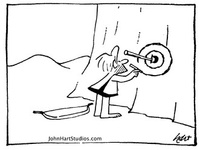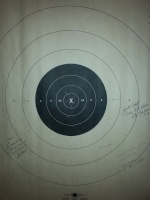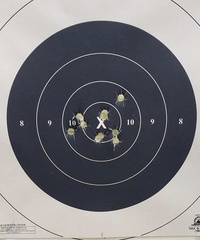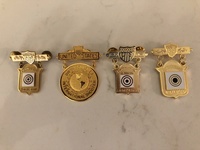Breaking the wrist: How do I stop?
+7
Doug Tiedt
Tim:H11
Allgoodhits
Ed Hall
Jon Eulette
Jack H
hengehold
11 posters
Page 1 of 1
 Breaking the wrist: How do I stop?
Breaking the wrist: How do I stop?
I am grouping well in the 10 ring at 25 yds but I get about 1 in 10 shots that goes straight up and into the 8 ring. These 12 oclock flyers are not on call and a friend tells me I am breaking my wrist. What the hell does that mean!! More importantly, how do I stop myself from doing it in the future?
I am under the impression that the 12 oclock flyers are from breaking the wrist, aka "limp-wristing" the shot. How do I go about locking up my wrist?
Thanks,
-Trevor
I am under the impression that the 12 oclock flyers are from breaking the wrist, aka "limp-wristing" the shot. How do I go about locking up my wrist?
Thanks,
-Trevor
hengehold- Posts : 424
Join date : 2017-11-26
Location : VA
 Re: Breaking the wrist: How do I stop?
Re: Breaking the wrist: How do I stop?
Two things
Press your thumb ham forward onto the grip as opposed to a chicken choke grip. Even have your thumb extended out sideways. ( I believe this also makes the trigger finger action more free. )
Learn what it feels like in your muscles near your elbow when you stiff your wrist. Learn the feel of lifting your wrist with a gun attached more than just lifting a gun only.
One more thing
Hold your head high so your arm has to raise a bit farther. Then your wrist will need to set downwards a little. The Euro bent grips are bent for a reason.
Press your thumb ham forward onto the grip as opposed to a chicken choke grip. Even have your thumb extended out sideways. ( I believe this also makes the trigger finger action more free. )
Learn what it feels like in your muscles near your elbow when you stiff your wrist. Learn the feel of lifting your wrist with a gun attached more than just lifting a gun only.
One more thing
Hold your head high so your arm has to raise a bit farther. Then your wrist will need to set downwards a little. The Euro bent grips are bent for a reason.

Jack H- Posts : 2698
Join date : 2011-06-10
Age : 75
Location : Oregon
 Re: Breaking the wrist: How do I stop?
Re: Breaking the wrist: How do I stop?
Relaxing your grip can cause high shots. You mostly see it at 50 yds but 25 can still be high. I’m assuming your shooting 45? Will be more pronounced with recoil vs. the .22
Work on being consistent with gripping pressure and arm tension.
Jon
Work on being consistent with gripping pressure and arm tension.
Jon

Jon Eulette- Posts : 4399
Join date : 2013-04-15
Location : Southern Kalifornia
 Re: Breaking the wrist: How do I stop?
Re: Breaking the wrist: How do I stop?
Learn to lock your wrist properly at the bench. If you adjust your wrist while on target, you can't achieve as good a lock as your initial lock from the bench.
 Re: Breaking the wrist: How do I stop?
Re: Breaking the wrist: How do I stop?
OK. My wrist has not locking notch to reference. What I am grasping from what I am hearing is to firmly clinch the fist, without thinking about the wrist position or angle. Whatever that "natural clinched fist" wrist position is, then that is the "natural lock" position. From there, adjust stance or rotation of grips, or grips themselves to achieve where the pistol (sights) needs to point. Is this "it"?Ed Hall wrote:Learn to lock your wrist properly at the bench. If you adjust your wrist while on target, you can't achieve as good a lock as your initial lock from the bench.
Thanks in advance.
Martin

Allgoodhits- Posts : 901
Join date : 2017-09-17
Location : Southport, NC
 Re: Breaking the wrist: How do I stop?
Re: Breaking the wrist: How do I stop?
Sorry, I answered on my way out the door, so I left out necessary details.Allgoodhits wrote:OK. My wrist has not locking notch to reference. What I am grasping from what I am hearing is to firmly clinch the fist, without thinking about the wrist position or angle. Whatever that "natural clinched fist" wrist position is, then that is the "natural lock" position. From there, adjust stance or rotation of grips, or grips themselves to achieve where the pistol (sights) needs to point. Is this "it"?Ed Hall wrote:Learn to lock your wrist properly at the bench. If you adjust your wrist while on target, you can't achieve as good a lock as your initial lock from the bench.
Thanks in advance.
Martin
When you get a "locked" grip on the pistol when you are getting ready to raise the gun, although the wrist is not truly locked, you have a pretty stable wrist that, if held in position, will pretty much resemble being locked. If, while you are on target, you wave the gun around in an effort to acquire your sight alignment, the wrist will never lock up as well as the initial lock did. (You should experiment with this to see if it is true.)
So, what you need to do is to work backward in your training, by finding what your wrist orientation is when the sighting system is aligned and learn to acquire that lock while on the bench. The sighting system alignment is the important part of this. As for aligning with the target, your wrist should not have to be disturbed.
 Re: Breaking the wrist: How do I stop?
Re: Breaking the wrist: How do I stop?
I think I have a "handle" on it better. For me to dissect what you say, it is the point or position at which my wrist is the most rigid.Ed Hall wrote:Sorry, I answered on my way out the door, so I left out necessary details.Allgoodhits wrote:OK. My wrist has not locking notch to reference. What I am grasping from what I am hearing is to firmly clinch the fist, without thinking about the wrist position or angle. Whatever that "natural clinched fist" wrist position is, then that is the "natural lock" position. From there, adjust stance or rotation of grips, or grips themselves to achieve where the pistol (sights) needs to point. Is this "it"?Ed Hall wrote:Learn to lock your wrist properly at the bench. If you adjust your wrist while on target, you can't achieve as good a lock as your initial lock from the bench.
Thanks in advance.
Martin
When you get a "locked" grip on the pistol when you are getting ready to raise the gun, although the wrist is not truly locked, you have a pretty stable wrist that, if held in position, will pretty much resemble being locked. If, while you are on target, you wave the gun around in an effort to acquire your sight alignment, the wrist will never lock up as well as the initial lock did. (You should experiment with this to see if it is true.)
So, what you need to do is to work backward in your training, by finding what your wrist orientation is when the sighting system is aligned and learn to acquire that lock while on the bench. The sighting system alignment is the important part of this. As for aligning with the target, your wrist should not have to be disturbed.
So then, the wrist position for this "lock: needs to come first. Then the grip which best enables one to pull the trigger without disturbing the sights/dot, After these have been determined, then the stance/position which enables the gun to point where you want it to point, without changing the grip or the wrist position. In other words the gun is locked in your grip, and your hand is locked at the wrist. Windage adjustment has to com from stance/position. So taking it another level. The shoulders get locked, the waist gets locked. The feet position do the windage adjustment. Thank you Sir.

Allgoodhits- Posts : 901
Join date : 2017-09-17
Location : Southport, NC
 Re: Breaking the wrist: How do I stop?
Re: Breaking the wrist: How do I stop?
Moving other things than the wrist doesn't detract from their stability like the wrist does. I don't actually lock the shoulder, waist, legs, etc., although I do hold them stable. Others may very well lock certain portions of their stance. I remember a Marine stance from twenty years ago that incorporated reaching into the off hand pocket, grabbing material, twisting the arm and straightening it, so as to provide a very locked off arm. Then, again, I've heard a prominent Marine shooter who puts his off hand on his waistband claim that a Marine doesn't stand with his hand(s) in his pocket(s).
 Re: Breaking the wrist: How do I stop?
Re: Breaking the wrist: How do I stop?
I spent a little time researching how to lock my wrist once. I gave up. Consistency in grip pressure and correct amount of pressure that works for the shooter, added with keeping your arm firm and straight and not like a wet noodle will help. A sudden relax or a relax of grip pressure as you press the trigger will give you wild flyers. Over exerting the firmness of the arm will fatigue you quickly. Your arm just needs to be firm enough to support the shot. You’re not in an arm wrestling match. At least this is what works for me.
Last edited by Tim:H11 on 8/2/2018, 7:47 am; edited 1 time in total

Tim:H11- Posts : 2133
Join date : 2015-11-04
Age : 36
Location : Midland, GA
 Re: Breaking the wrist: How do I stop?
Re: Breaking the wrist: How do I stop?
Ed (or anyone),
I've heard others also state locking one's wrist and/or arm and just raising it. Maybe I just need another 10-20K rounds of practice, but I find actually locking the arm/wrist quite difficult to do as I
am a cross dominant shooter. The bench is too high to give me enough clearance to achieve this
at rest. [Right now I am just working on consistency ala Tim:H11's post and was told that I actually minutely squeeze the trigger with all fingers, so I'm concentrating on just moving my trigger finger.]
Any suggestions?
Thanks,
Doug
I've heard others also state locking one's wrist and/or arm and just raising it. Maybe I just need another 10-20K rounds of practice, but I find actually locking the arm/wrist quite difficult to do as I
am a cross dominant shooter. The bench is too high to give me enough clearance to achieve this
at rest. [Right now I am just working on consistency ala Tim:H11's post and was told that I actually minutely squeeze the trigger with all fingers, so I'm concentrating on just moving my trigger finger.]
Any suggestions?
Thanks,
Doug
Doug Tiedt- Posts : 150
Join date : 2015-05-29
 Re: Breaking the wrist: How do I stop?
Re: Breaking the wrist: How do I stop?
I'm failing to picture, "The bench is too high to give me enough clearance to achieve this at rest."
Unless the bench is obscuring your target, I don't see this. You don't want to be locked at rest, anyway. But you should straighten your arm and lock it as best as you can, before raising it to your line of sight. You should learn where this lock is by finding out where the raise will align your sighting system.
As for finger exercises, position your empty fingers as though they are around your grip and practice moving only the trigger finger while watching the rest.
Unless the bench is obscuring your target, I don't see this. You don't want to be locked at rest, anyway. But you should straighten your arm and lock it as best as you can, before raising it to your line of sight. You should learn where this lock is by finding out where the raise will align your sighting system.
As for finger exercises, position your empty fingers as though they are around your grip and practice moving only the trigger finger while watching the rest.
 Re: Breaking the wrist: How do I stop?
Re: Breaking the wrist: How do I stop?
When watching other shooters, here’s an observation. Expert and below typically have a too relaxed, loose, lazy lift of the gun from the bench to the target. A master and above will have a rigid, firm, solid mechanical lift from the bench. The rigid, firm lift starts with extended arm (as if shooting) that is only moving at the shoulder. Wrist and elbow are already in position.
Have someone video you when shooting. Be honest with yourself and don’t change anything when videoing. Watch it and make corrections.
I have corrected several shooters this year on their stance and lift and they have improved greatly. It’s just fine tuning to the next level.
Jon
Have someone video you when shooting. Be honest with yourself and don’t change anything when videoing. Watch it and make corrections.
I have corrected several shooters this year on their stance and lift and they have improved greatly. It’s just fine tuning to the next level.
Jon

Jon Eulette- Posts : 4399
Join date : 2013-04-15
Location : Southern Kalifornia
 Re: Breaking the wrist: How do I stop?
Re: Breaking the wrist: How do I stop?
When I throw a shot high, unexplained, it has nothing to do with me breaking my wrist, it has to do with being in a hurry to look over the top of the pistol to see where the shot fell. I actually start to look over the top of the pistol before the shot fires, and the pistol follows my eye, resulting in a flier out the top.
After you get done trying all of the above, if it does not work, try concentrating on re-acquiring your sight picture again after the shot and don't look at where the shot went.
After you get done trying all of the above, if it does not work, try concentrating on re-acquiring your sight picture again after the shot and don't look at where the shot went.
NuJudge- Posts : 263
Join date : 2011-09-22
Age : 67
Location : SE Michigan
 Re: Breaking the wrist: How do I stop?
Re: Breaking the wrist: How do I stop?
Ed Hall wrote:I'm failing to picture, "The bench is too high to give me enough clearance to achieve this at rest."
Unless the bench is obscuring your target, I don't see this. You don't want to be locked at rest, anyway. But you should straighten your arm and lock it as best as you can, before raising it to your line of sight. You should learn where this lock is by finding out where the raise will align your sighting system.
As for finger exercises, position your empty fingers as though they are around your grip and practice moving only the trigger finger while watching the rest.
Poor wording choice on my part... when I try to get into position at rest on the bench, it is not comfortable or my elbow is bent slightly.
Having developed tendonitis from doing things wrong in this sport, I am perhaps a bit sensitive when things are not feeling comfortable
and I have to repeat the action a couple hundred times in a row.
I do "straighten/lock" on the way as I raise my arm, but I am thinking I'm not consistent in my final position.
Obviously solution came to me this morning... back up a bit from the bench! I also like to have my gun orientated with the grip vertical while at the bench, but maybe if I rotate it a bit while keeping the muzzle downrange that might help me?
Thanks for the finger exercise tip. I have noticed better groups when I really concentrate on just moving my trigger finger. And as soon as I slack off my awareness even a bit, the group size opens up.
Thank you.
Doug Tiedt- Posts : 150
Join date : 2015-05-29
 Re: Breaking the wrist: How do I stop?
Re: Breaking the wrist: How do I stop?
Ed Hall wrote:As for finger exercises, position your empty fingers as though they are around your grip and practice moving only the trigger finger while watching the rest.
This is a good one. Do this. Do it a lot.

john bickar- Posts : 2279
Join date : 2011-07-09
Age : 100
Location : Menlo Park, CA
 Re: Breaking the wrist: How do I stop?
Re: Breaking the wrist: How do I stop?
Jon Eulette wrote:When watching other shooters, here’s an observation. Expert and below typically have a too relaxed, loose, lazy lift of the gun from the bench to the target. A master and above will have a rigid, firm, solid mechanical lift from the bench. The rigid, firm lift starts with extended arm (as if shooting) that is only moving at the shoulder. Wrist and elbow are already in position.
Jon
This too.

john bickar- Posts : 2279
Join date : 2011-07-09
Age : 100
Location : Menlo Park, CA
 Re: Breaking the wrist: How do I stop?
Re: Breaking the wrist: How do I stop?
A lot of good content here from some top shooters, so a little wary about adding my thoughts, but sometimes I cannot help myself.
hengehold, it doesn't sound like you are doing this, but I have seen some shooters add what I call a Cowboy Flip to their last shot. They unknowing flip the pistol up on the last shot because that is what they have seen in the movies. They do it in the movies to add theatric flair. But in real shooting, you get a high flyer. If by chance this is what you are doing, then as NuJudge suggested, follow all the good advice here and re-acquire your sight picture again after the shot.
Doug Tiedt, do you use a bench block or bag to help hold the gun, wrist and arm in position when at rest? It was discussed in this thread
https://www.bullseyeforum.net/t9398-two-questions-about-a-brian-zins-youtube-video
hengehold, it doesn't sound like you are doing this, but I have seen some shooters add what I call a Cowboy Flip to their last shot. They unknowing flip the pistol up on the last shot because that is what they have seen in the movies. They do it in the movies to add theatric flair. But in real shooting, you get a high flyer. If by chance this is what you are doing, then as NuJudge suggested, follow all the good advice here and re-acquire your sight picture again after the shot.
Doug Tiedt, do you use a bench block or bag to help hold the gun, wrist and arm in position when at rest? It was discussed in this thread
https://www.bullseyeforum.net/t9398-two-questions-about-a-brian-zins-youtube-video
joy2shoot- Posts : 570
Join date : 2014-08-02
Location : North Carolina
 Re: Breaking the wrist: How do I stop?
Re: Breaking the wrist: How do I stop?
joy2shoot wrote:
Doug Tiedt, do you use a bench block or bag to help hold the gun, wrist and arm in position when at rest? It was discussed in this thread
https://www.bullseyeforum.net/t9398-two-questions-about-a-brian-zins-youtube-video
Yes, I do use a bench block (three 45 ammo trays duct taped together). I usually rest the curve of the trigger guard in one of the ammo holes, to prevent the slide being touched. So the slide is approximately at a 45 degree angle pointed at the floor in front of me.
So I adjusted my position a bit, tried it without the bench block but went back to it. I moved back from the bench so I could keep my elbow straight. Just before lifting the pistol I would take a breath, "lock" my elbow and wrist into position and then lift my arm at the shoulder in a controlled manner.
I think this was helping, along with a couple of other tips I am attempting to apply (sometimes successfully). Now all I need is repetition (and to update my shot plan).
Thanks all.
Doug Tiedt- Posts : 150
Join date : 2015-05-29
 Re: Breaking the wrist: How do I stop?
Re: Breaking the wrist: How do I stop?
Thank you to that mental picture. I am definitely in the group that sloppily throws the pistol up in front of my face. Will work on the rigid arm raising process.Jon Eulette wrote:When watching other shooters, here’s an observation. Expert and below typically have a too relaxed, loose, lazy lift of the gun from the bench to the target. A master and above will have a rigid, firm, solid mechanical lift from the bench. The rigid, firm lift starts with extended arm (as if shooting) that is only moving at the shoulder. Wrist and elbow are already in position.
Have someone video you when shooting. Be honest with yourself and don’t change anything when videoing. Watch it and make corrections.
I have corrected several shooters this year on their stance and lift and they have improved greatly. It’s just fine tuning to the next level.
Jon
-T
hengehold- Posts : 424
Join date : 2017-11-26
Location : VA
 Re: Breaking the wrist: How do I stop?
Re: Breaking the wrist: How do I stop?
I prefer to twirl the pistol around my trigger finger and blow the smoke away from the barrel after my last shot. Maybe that has something to do with it?joy2shoot wrote:A lot of good content here from some top shooters, so a little wary about adding my thoughts, but sometimes I cannot help myself.
hengehold, it doesn't sound like you are doing this, but I have seen some shooters add what I call a Cowboy Flip to their last shot. They unknowing flip the pistol up on the last shot because that is what they have seen in the movies. They do it in the movies to add theatric flair. But in real shooting, you get a high flyer. If by chance this is what you are doing, then as NuJudge suggested, follow all the good advice here and re-acquire your sight picture again after the shot.
Doug Tiedt, do you use a bench block or bag to help hold the gun, wrist and arm in position when at rest? It was discussed in this thread
https://www.bullseyeforum.net/t9398-two-questions-about-a-brian-zins-youtube-video
hengehold- Posts : 424
Join date : 2017-11-26
Location : VA
 Follow through
Follow through
The other post are very good. Adding one additional item. If you are following completely through with the shot and exaggerating the follow through, it is near impossible to break the wrist or have your grip pressure change much.
mhayford45- Posts : 259
Join date : 2013-02-21
Location : MI
 Re: Breaking the wrist: How do I stop?
Re: Breaking the wrist: How do I stop?
mhayford45 wrote:The other post are very good. Adding one additional item. If you are following completely through with the shot and exaggerating the follow through, it is near impossible to break the wrist or have your grip pressure change much.
OK, that makes some sense to me. I will consider "breaking the wrist" to be a follow through related symptom and focus on follow through. Thanks.
-T
hengehold- Posts : 424
Join date : 2017-11-26
Location : VA
Page 1 of 1
Permissions in this forum:
You cannot reply to topics in this forum